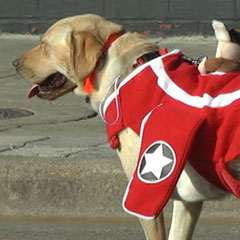October 30, 2017
How to make Halloween a treat for pets, too
Submitted by Division of Communications and Marketing

Halloween can be fun for children and adults alike, but for pets it can be a potentially dangerous holiday.
Susan Nelson, clinical professor at Kansas State University's Veterinary Health Center, shares some tips on how to make the holiday a little safer and less stressful for furry family members.
• If your pet will have a costume, try it on the pet in advance to give it time to get used to it.
• Ensure that pets can see, hear, smell and breathe when in costume.
• If you choose to dress up your pet, avoid costumes that have any loose or small parts that can be pulled off and ingested.
• If your pet seems distressed, allergic or shows abnormal behavior with a costume, consider having it wear a Halloween themed bandana instead.
• Strange visitors in scary costumes and loud noises may cause even the most social and/or calm animal to be frightened and react negatively. If concerned, keep your pet in a back room with the radio or TV turned on to help drown out noise caused by ringing doorbells and excited children, or to prevent them from running out the door.
• Make sure your pet has proper forms of identification, such as a microchip or tags. A reflective collar may also help others to spot your pet, should they go missing at night.
• Don't keep candy out in easily accessible places. Chocolates, sugar-free candies, raisins and some nuts can be toxic to pets. Candy wrappers and lollipop sticks can also become choking hazards or gastrointestinal foreign bodies if ingested.
• Cats, especially black ones, are often sought after with cruel intentions during Halloween, and caution needs to be exercised during the time to keep them safe.
• Keep pets away from electrical cords and decorations. Chewing on electrical cords can lead to life-threatening electrocution and burns. Decorations, especially corncobs, can be ingested and cause obstructions in the gastrointestinal tract.
• Keep lit pumpkins and candles out of reach, as they can burn your pet. A frightened or curious pet also can tip over a candle, which could lead to a house fire.
For more information, contact the Veterinary Health Center at 785-532-5690.
